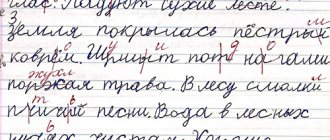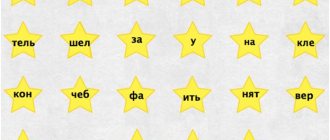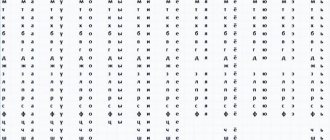This speech disorder is dysgraphia, a fairly “young” concept in the field of pathologies of speech development. Relatively recently, only since the end of the 19th century, this state of children’s speech began to be deeply examined and developed into a separate science. Many researchers, when working with children, noticed and described similar deviations in speech and grammar.
At the initial stage of the study, reading and writing disorders were considered a single disorder. But over time, they began to divide it into narrower concepts: dysgraphia - a writing disorder, dyslexia - a reading disorder. In its pure form, any of the above pathologies are rare. More often than not, reading also suffers along with a writing disorder. Children who demonstrate gross agrammatical violations in writing also deviate from the norm when reading. Therefore, in the conclusions of speech therapists after diagnosing children, you can often find a comprehensive meaning that will look like this: “reading and writing impairment.”
In the early period of studying this problem, it was believed that the initial cause of this pathology was a lack of intellectual development. But over time, it was proven that reading and writing disorders are not associated with intellectual underdevelopment. The examined children with disabilities demonstrated good results in mathematical skills - they solved problems and examples well, thereby showing good logical abilities, which fundamentally contradicts the opinion of mental impairment.
When talking about reading and writing disorders, it is necessary to clarify some points related to terminology. Very often, our Russian patients, when contacting neurologists and speech therapists, confuse such concepts as “dysgraphia” and “dyslexia”. Now in the age of complete availability of information, people have the opportunity to receive news from all over the world. Thus, the concept of “dyslexia” has come into use among Russian citizens; in most cases, as practice shows, this diagnosis is picked up from world-famous Hollywood stars and is actively tried on for themselves. Without fully understanding the meaning of the term “dyslexia,” people are confused about the real condition of the disorder.
In the West, the diagnosis of “dyslexia” is understood as a general combined disorder of reading and writing. Russian speech therapists tend to divide this concept into a narrower meaning: “dysgraphia” is a writing disorder, and “dyslexia” in this case is a reading disorder.
Causes of dysgraphia
For all the time they have been studying this problem, researchers have not come to a consensus about the reasons for its occurrence. Some authors agree with the Soviet neurologist Tkachev, who believed that the cause of reading and writing disorders is poor memory in children. Those. they do not remember letters, syllables, sounds well and therefore cannot correlate sounds with letters.
But there is another opinion, which also found its followers among researchers of this pathology, for example, the Soviet psychiatrist Mnukhin S.S., who insisted that the cause of these problems are negative hereditary factors, such as alcoholism, psychopathy, parental epilepsy, birth injuries. It was also noted that, along with writing impairment, children have a number of other signs. For example, it is difficult for such children to tell about themselves - to give the address, the names of their parents; they mistakenly call the seasons, confuse the days of the week with the months; cannot reproduce the counting and names of the days of the week in strict sequence, even after repeated repetition.
At present, the fragmentation of opinions remains in its original form. Modern authors also identify two possible groups of reasons. The first is associated with a hereditary factor, the presence of similar problems in parents and close relatives. The second group includes organic disorders in the perinatal or postnatal period. Uneven development of the fetal brain structures during pregnancy leads to improper formation of certain functions.
But in modern society, a third direction is also being formed, which is correlated with the cause of the formation of reading and writing impairments - this is the impact of the modern social environment and, therefore, this type of impairment is acquired. Those. Such children do not have hereditary factors, and there are also no organic lesions of the brain structures. This means that the disorder was formed under the influence of incorrectly selected forms of education: untimely start of teaching a child to read and write, developing writing skills at an unacceptably early age, the use of teaching materials that are not appropriate for the age and maturity of the child.
Correction and correction of dysgraphia at a speech therapy center in Moscow
Dysgraphia cannot be corrected using a school curriculum ; special classes with a speech therapist, physical therapy, and home exercises will be needed. Corrective work on dysgraphia is built individually with each student, since problems with writing can be different, as well as the child’s reaction to corrective classes.
To correct dysgraphia, a speech therapist develops a system for filling gaps that are important for developing writing skills. Additionally, work is being done to develop speech, expand vocabulary, improve attention and memory.
Physical therapy and games with magnet letters are allowed, especially for preschoolers and primary schoolchildren.
Our specialists will help eliminate errors in a child’s writing, expand vocabulary, develop speech hearing, train auditory attention and auditory-speech memory.
Symptoms of dysgraphia
Most often, dysgraphia begins to be identified in elementary school, after the child masters his first writing skills. Already in the second half of the first year of study, you can notice frequently repeated errors of an “incomprehensible” nature. They should not be confused with spelling errors, which would be the norm for an elementary school student. If a student confuses the rules for writing “Zhi-Shi”, or checking for stressed and unstressed words, then this is a natural process in mastering Russian grammar. But if a child persistently writes prepositions together, and prefixes, on the contrary, separately from the word, and also makes many other distortions, which will be discussed in more detail below, then this gives the teacher a reason to recommend that parents visit a speech therapist.
It is very important to understand that dysgraphia does not appear suddenly. The formation of this pathology is based on a long process that begins in early childhood. When diagnosing a disorder, earlier problems that were present throughout the preschool period always come to the surface. All insufficiently formed elements of speech development during the school years move from oral speech to writing. Speech formation disorders are unique to each child, and therefore children’s writing impairments also vary.
If in preschool age the child had a predominant delay in the grammatical form of speech, then the writing will contain errors of a grammatical nature - fused spelling of words and prepositions, etc., if the child in preschool age had problems of a sound nature, then accordingly the writing will be dominated by phonemic type errors.
Types of dysgraphia
There are several forms of dysgraphia:
- articulatory-acoustic dysgraphia;
- dysgraphia based on phoneme recognition disorders;
- dysgraphia due to impaired language analysis and synthesis;
- agrammatic dysgraphia;
- optical dysgraphia;
It is rare that dysgraphia manifests itself in a single form; more often it is of a mixed nature and depends on the severity of the disorders in the preschool period. And then we can see errors in writing that are both grammatical and phonemic at the same time.
For a more complete understanding of how different types of dysgraphia manifest themselves, you can look at the characteristics of these disorders, which were compiled and presented by specialists from the Department of Speech Therapy of Leningrad State Pedagogical Institute named after. A.I. Herzen.
Articulatory-acoustic dysgraphia - this form occurs in children with insufficient development of sound analysis and synthesis. With acoustic dysgraphia, children have difficulty distinguishing sounds. Especially – similar in articulation and sound. In writing, this looks like replacement of letters, confusion and omissions, as well as incorrect reflection of sound pronunciation in writing. Those. the child writes in the same way as he pronounces. Typically, this type of disorder is based on a disorder in preschool age in the form of dyslalia (impaired sound pronunciation), dysarthria, and rhinolalia.
Dysgraphia based on violations of phonemic recognition - with this form in writing, the child replaces phonetically similar sounds (ts-t, ch-sch, p-b, m-, etc..). A feature of this dysgraphia is that in oral speech the child pronounces all sounds correctly. You can also observe in writing a defect in softening (“album”) and replacing vowel sounds - e-i, o-u (hand-“roka”, chalk - “mil”).
Dysgraphia due to a violation of language analysis and synthesis - in writing the structure of sentences and words is distorted, prepositions are written together, prefixes are written separately, individual words are broken (in the forest - “in the woods”, came - “came”, there is a house - “stoidom”). There are omissions of vowels and consonants (work - “rbota”, tree - “dervo”, hat - “shaka”, pear - “rusha”, etc.), addition of extra letters (pines - “pines”), rearrangement of letters and syllables (grass - “gate”).
Agrammatic dysgraphia - is associated with underdevelopment of the grammatical structure of speech, sentences and words are distorted, children have difficulties in forming the plural of nouns, and their diminutive forms are also erroneously formed, the sequence of sentences is not observed, semantic connections are not observed (houses - “houses” , chairs - “chairs”, “many pencils”, chickens - “chickens”, “one nesting doll”, etc.). Such violations are part of lexico-grammatical underdevelopment of speech.
Optical dysgraphia is an unstable visual perception, letters are not recognized and are perceived differently in each word. In writing, such replacements look like this: p-i, p-n, u-i, ts-sch, sh-i, m-l, b-d, p-t, n-k... Mirror writing of letters is also possible, especially for left-handed people.
Motor – often associated with handwriting; in the process of writing, problems arise in the movements of the hand and a violation of the perception of letters with a visual image.
All of these forms of dysgraphia are permanent and stable. In some cases, dysgraphia is accompanied by non-speech deviations, such as impaired memory, distracted attention, and mental illness.
Correction of writing disorders in older schoolchildren
Correction of dysgraphia in older schoolchildren is necessary depending on its type. However, it is worth considering that some children may experience a mixture of several types of dysgraphia. Therefore, taking into account violations of written speech, correctional work may consist of the following sections:
- overcoming problems with writing caused by a violation of language analysis and synthesis;
- elimination of agrammatic dysgraphia;
- correction of optical dysgraphia;
- overcoming acoustic dysgraphia.
Dysgraphia due to impairment of language analysis and synthesis
The main tasks of correcting dysgraphia caused by a violation of language analysis and synthesis include the formation, gradual development and improvement of skills in analyzing sentence structure, as well as syllabic and phonemic synthesis and analysis.
The development of these skills involves the following stages of work:
- the child’s determination of the number, place and sequence of words in a sentence;
- isolating a vowel sound from a syllable or word;
- distinguishing vowel and consonant sounds in a word;
- determining the number and place of a syllable in a word;
- composing words by rearranging syllables and adding sounds;
- isolating the first and last sound from a word, as well as determining its place;
- determination of sequence and positional place in a word.
To develop skills and consolidate them during correctional classes, speech therapists use a set of various exercises:
- Insert the missing letters in words (for example, kry...a, ru...a);
- Choose words in which the sound specified by the speech therapist would be in first, second, third place. For example, if you come up with words with the sound [k] using this scheme, then they could be a cat (in first place), a window (in second place), and a poppy (in third place).
- Add several sounds to one syllable to create different words.
- Choose words with the same number of sounds from one sentence.
- Choose words with a given number of sounds (for example, with three sounds - smoke, house, cancer.
- Children first roll the dice and then come up with a word consisting of sounds in an amount that corresponds to the number of dots on the dice.
- “Sound arithmetic” - children are asked to add or remove one sound from a word to end up with a new word.
- “Finest hour” - children need to create new words from the letters of the word “picture”: whale, tina, thread, tank.
- The word is a mystery. The speech therapist writes the first letter of the word and puts dots in place of all the others. Students need to come up with words starting with this letter.
- Children need to name words in which the letters are in reverse order.
Agrammatic dysgraphia
The main tasks of correcting this type of dysgraphia include the formation and improvement of the following skills: the ability to most accurately correlate certain words with a phenomenon, object, action; understand the morphological composition of words; be able to formulate your speech grammatically correctly; speak coherently.
To develop these skills, the following areas of correctional work are recommended:
- First, the speech therapist clarifies the meanings of words that are in the child’s vocabulary, which is then gradually enriched in the learning process. This happens due to the accumulation of new words that relate to different parts of speech and due to the development in children of skills to actively use word formation methods. Thus, the child gradually develops a consistent accumulation of “nests of related words.”
- Formation and development of grammatically correct speech through mastering the connection of words in sentences, phrases, and models of syntactic constructions.
- Development of skills to speak coherently, which includes the selection of certain linguistic means for utterance, taking into account the goals of communication, establishing the sequence of utterances, improving the ability to construct and then rebuild sentences according to patterns.
Optical dysgraphia
During correctional work to eliminate optical dysgraphia, the doctor concentrates on the development of visual perception and the subsequent differentiation of mixed letters in writing. To overcome optical dysgraphia, it is necessary to teach the child ideas about size, shape and color, the design of letters, their location and selection, and orientation in the surrounding space. You can consider how optical dysgraphia can be eliminated in practice using the example of exercises aimed at differentiation in words i-u.
- To begin, the speech therapist focuses on the development of spatial concepts in the child. To do this, he can ask the student to draw these letters with a certain sequence of movements.
- The teacher then moves on to develop phonemic analysis and synthesis. To do this, he writes several numbers and letters on the board (p, w, i, g, y, a, k). Afterwards, the speech therapist gives the students the following tasks: select only letters and make a word (toy) from them, determine which sound is in the first and fourth place of the resulting word.
- At the next stage of the lesson, the speech therapist offers the student a visual analysis of the letters being studied. To do this, the child must look at the letters and understand what elements they consist of. He should also find similar and distinctive features between the letters.
- To consolidate the understanding of the differences between letters, the student performs exercises. For example, he needs to copy words, while inserting missing letters instead of dots (p...ram...da). Another exercise involves making new words from the letters of the word “truck.” Then in these words the student needs to emphasize the letters studied in the lesson.
Acoustic dysgraphia
The objectives of correctional work to overcome acoustic dysgraphia include the development of the following skills:
- auditory perception;
- ideas about sounds;
- phonemic analysis and synthesis;
- distinguishing mixed sounds by sonority and dullness, hardness and softness.
The training program is based on the child’s comparison of mixed sounds in auditory and pronunciation terms, as well as clarification of the auditory and pronunciation image of the mixed sounds.
How the development of skills to distinguish letters by ear occurs in practice can be considered using the example of practical classes on differentiating the sounds [d] and [t].
- First, the speech therapist asks students to compare the articulation of the sounds [d] and [t]. First, he pronounces these sounds himself, after which he asks the students to repeat after him. Students can try putting their hand to their throat while pronouncing sounds to listen to how much the throat trembles when pronouncing the sound [d]. As a result, children must learn that the sound [d] is pronounced with the participation of a voice, therefore it is voiced, and [t] is pronounced without a voice, therefore it is deaf.
- Students are given gray and black cards. When they hear the sound [d] in a word, they must pick up a black card, and when they hear [t] - a gray one.
- Children are asked to look at pictures with a house, a bucket, a honeycomb, grass, a garden, a chair, and an arrow. Then these pictures need to be laid out under the letters d and t.
- Students need to insert the missing letters d or t into the words: truck., boro.a, s.rela, vor.a, gr.usnik, ve.ka.
Methods for diagnosing dysgraphia
If you yourself have noticed “funny” writing mistakes that your child makes when doing school assignments, or your class teacher has pointed them out to you, you should consult a speech therapist. The doctor's opinion will be most valuable and reliable if you bring several school notebooks to the appointment.
The need for an integrated approach
Each speech disorder consists of a complex of symptoms. Therefore, the examination of the child must be comprehensive. A neurologist examines for neurological diseases that may interfere with the correct formation of written speech (such as hyperactivity, ADHD, neurosis-like conditions, etc.). A child psychologist will help identify emotional aspects that prevent a child from fully mastering writing, problems with memory and attention. A child psychotherapist will confirm the absence of mental retardation, autism spectrum and mental illness. Additionally, the state of vision and hearing is examined. The speech therapist will establish the level of formation of the grammatical structure of speech, the development of motor functions, the state of phonemic analysis, the consistency of the vocabulary, and deviations in the formation of sound pronunciation.
Sign up for diagnostics To accurately diagnose the disease, make an appointment with specialists from the Family Doctor network.









